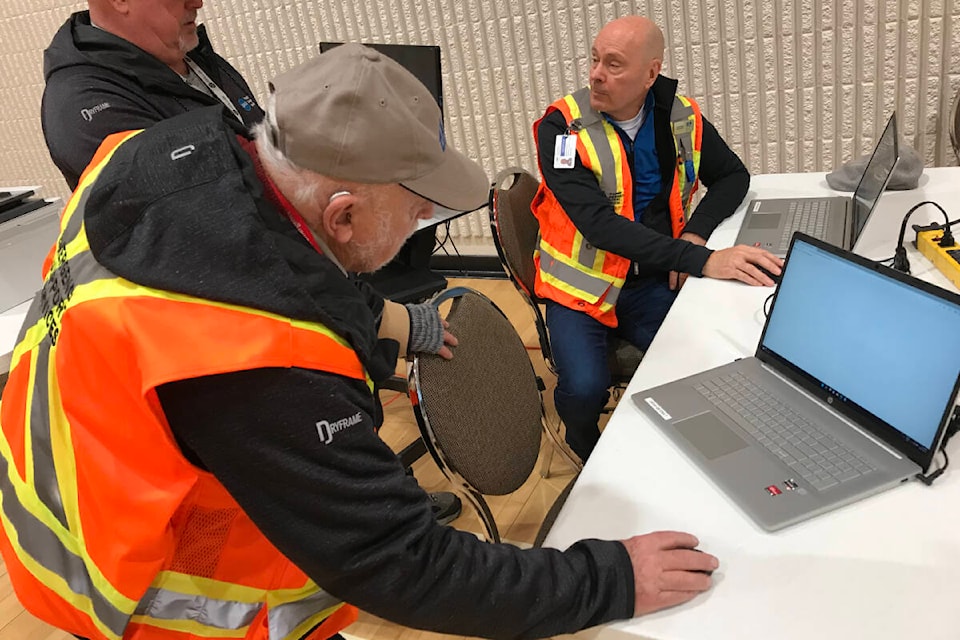The Oceanside Emergency Support Services (OESS) group is ensuring its members are prepared for future emergencies, with the help of a new electronic evacuee registration referral system.
In the event of an emergency, such as a fire or flooding, displaced residents are directed to reception centres, such as Qualicum Beach Civic Centre, where OESS simulated the process of setting up a centre on Jan. 10. OESS is a branch of Emergency Management Oceanside (EMO).
The new online Evacuee Registration and Assistance (ERA) tool will allow volunteers to quickly register evacuees and set them up for referrals, such as food, shelter and incidentals such as medication or pet supplies, according to Chris James, OESS coordinator and director.
“What you would need in an emergency for 72 hours,” James said.
ERA saves valuable time and removes an enormous amount of paperwork, according to Mike Foster, one of three OESS volunteer directors.
People can even choose to register themselves on their device and come to the reception with a number assigned. With that registration number, an evacuee can go right to the referrals process, or be redirected to another centre if that location is overwhelmed — ERA is a province-wide system.
READ MORE: After service station destroyed by fire, painting fundraiser planned for Bowser family
James went to work in an emergency operations centre in Kamloops in 2017 and said the huge number of evacuees resulting from forest fires alerted emergency management to the need for a new system.
“They had upwards of 35,000 evacuees converge into Kamloops,” James said. “I walked into one of the rooms where they had literally hundreds and hundreds of banker boxes full of paper forms that needed to be processed in Victoria. So that was where they first identifed the problem.”
OESS is in the process of training its members on the new system, but if there was a situation with 50-100 evacuees, James said the new system could be used right away.
When volunteers get the call to set up a reception centre (there are seven locations spread out from Nanoose to Bowser), the first person to arrive will be in charge and get the process started, then pass off command when possible.
Members will set up tables and chairs for registration, referrals, communcations and logistics, which involves finding lodging for displaced people.
They take turns on the “Level 1” role, carrying a special phone which will take a call from emergency dispatch in Campbell River, according to Foster.
“You could get a call anytime of day or night,” said Foster. “We’ve had calls at midnight, we’ve had calls at four in the morning for us to respond.”
Oceanside Emergency Communications Team members operate a communcation centre with a VHF radio, which can maintain communications with a main centre at Qualicum Beach Town Hall, the Parksville Civic and Technology Centre, Victoria, or anywhere in the world. That comes in handy when cell service goes down or the power goes out — reception centres have backup generators.
“People will say ‘texting is effective’,” James said. “But if the emergency operations centre manager or operations manager, finance manager, needs to get ahold of 10 people — trying to reach them at the same time, it doesn’t work.”
Communication between centres is critical for sending situation reports, resource requests and shifting volunteers to a different centre if needed, James said.
December was a busy month for OESS. Early in the month, the team responded late at night to assist a family evacuated after a housefire. On Dec. 24, OESS were placed on alert by Emergency Management and Climate Readiness (EMCR) that their assistance may be required to staff group lodging for evacuees at another community due to potential flooding. Fortunately the waters receded and the service was not neccessary, according to a news release by EMO.
On Dec. 27, OESS received a call from EMCR asking for assistance for 43 evacuees from a flooded community just outside of the region. Within an hour OESS had mobilized seven volunteers and sourced hotel rooms for all evacuees, who were registered, checked in to rooms and provided meal vouchers by 10 p.m. OESS assisted 77 people evacuated from their homes in 2022, according to the release.
Training exercises are held approximately once per month.
Having enough people is critical and new volunteers are always welcome.
For more information about volunteering with OESS, visit the EMO website. No certification or experience is required, only dedication and a willingness to respond to an emergency at all hours of the day or night.
